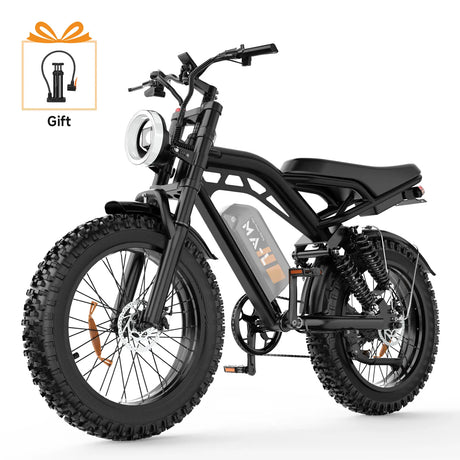 E-bikes can absolutely be worth it, especially if you're looking for a flexible, sustainable, and cost-effective way to get around. Here are some key factors to consider:
E-bikes can absolutely be worth it, especially if you're looking for a flexible, sustainable, and cost-effective way to get around. Here are some key factors to consider:1. Convenience and Speed
E-bikes allow you to travel faster than a traditional bike with less effort, which can save you time, especially on longer commutes. High-speed e-bikes can reach speeds of 20-28 mph (and some even higher), making them a viable alternative to driving for shorter trips.2. Health Benefits
E-bikes provide a good balance of exercise and assistance, so you still get physical activity without being completely exhausted. They’re great for people who might have limitations that make a traditional bike too demanding.3. Environmental Impact
E-bikes produce zero emissions, which helps reduce your carbon footprint. If you use your e-bike in place of a car, especially for short trips, you’re making a positive environmental impact.4. Cost Savings
E-bikes have a higher initial cost than traditional bikes, but they are far cheaper to operate than cars. Once you factor in gas, parking, and maintenance costs, an e-bike can be much more economical in the long run. They’re also relatively low maintenance compared to cars or motorcycles.5. Range and Battery Life
Most e-bikes have a battery range of 20 to 50 miles, and many models now offer options for higher-capacity batteries. For national parks like Yellowstone, where distances can be long, range is a key factor to consider, especially if you're planning extended rides.6. Fun and Versatility
E-bikes are fun to ride! They allow you to cover more ground without getting overly tired, which is ideal for places like Yellowstone where you might want to explore without worrying too much about stamina.
Considerations
Cost: E-bikes range from a few hundred to several thousand dollars, so it’s a bit of an investment.
Local Regulations: Some parks and places have specific regulations about e-bike usage. For Yellowstone, for example, only certain classes may be allowed on certain trails or roads.
Maintenance: E-bikes have extra components (motor, battery), which may require occasional servicing.
Overall, if you value a flexible and eco-friendly way to get around, an e-bike is often well worth it.
E-Bike Basics: Cycles with Motors and Batteries for Pedal Assistance.
 E-bikes, or electric bicycles, combine traditional cycling with electric components to enhance the riding experience. Here are the basics:
E-bikes, or electric bicycles, combine traditional cycling with electric components to enhance the riding experience. Here are the basics:
1.Components:
Motor: Provides pedal assistance. Located in the hub (front or rear) or the mid-frame.
Battery: Powers the motor; typically rechargeable lithium-ion. The capacity affects the range and power.
Controller: Regulates power delivery from the battery to the motor based on rider input.
Pedal-assist system: Adjusts the motor output based on how hard you’re pedaling. Some e-bikes also have a throttle for direct power without pedaling.
2.Types of E-Bikes:
Class 1: Pedal-assist only; motor provides assistance only when pedaling, up to 20 mph.
Class 2: Throttle-assisted; can be powered without pedaling, also up to 20 mph.
Class 3: Higher-speed pedal-assist; motor can assist up to 28 mph.
3.Benefits:
Ease of Use: Makes cycling accessible for various fitness levels.
Extended Range: Allows for longer rides without as much physical exertion.
Environmental Impact: Offers a greener alternative to cars for commuting.
4.Considerations:
Weight: E-bikes are heavier than traditional bikes due to the motor and battery.
Maintenance: Similar to regular bikes, but with added complexity from electrical components.
Legality: Regulations vary by region regarding where e-bikes can be used and their classification.
If you’re looking to dive deeper into any specific aspect or have questions about using an e-bike in a particular setting like Yellowstone, let me know!
E-Bikes vs Regular Bicycles: Which is Better?
 Choosing between e-bikes and regular bicycles depends on your preferences and needs. Here’s a comparison to help you decide:
Choosing between e-bikes and regular bicycles depends on your preferences and needs. Here’s a comparison to help you decide:
1.E-Bikes
Pros:
Less Physical Strain: Ideal for commuting or long rides, especially on hilly terrain, as the motor provides assistance.
Faster Speeds: Can help you maintain higher speeds without excessive effort, making longer distances more manageable.
Accessibility: Great for those who may have physical limitations or are returning to cycling after a long break.
Convenience: Can reduce sweat and fatigue, making them suitable for commuting without needing a change of clothes.
Cons:
Weight: Generally heavier due to the motor and battery, which can make them harder to handle if the battery runs out.Cost: Typically more expensive than regular bicycles, both in initial investment and maintenance.
Complexity: More components mean more potential for mechanical issues and maintenance needs.
2.Regular Bicycles
Pros:
Simplicity: Fewer components to maintain and repair, making them easier to handle.
Cost-Effective: Generally lower initial cost and maintenance expenses.
Exercise: Provides a better workout since you rely entirely on your physical effort.
Lightweight: Easier to handle and transport, especially for activities like bikepacking or racing.
Cons:
Physical Demand: Can be more challenging, particularly on steep inclines or long distances.
Speed Limitations: You’ll need to exert more effort to maintain higher speeds, which can be tiring.
Less Accessible: Might not be suitable for everyone, especially those with fitness limitations.
3.Conclusion
If you prioritize ease of use, speed, and accessibility, especially for commuting or long rides, an e-bike might be the better choice. If you value simplicity, workout intensity, and lower costs, a regular bicycle could be the way to go. Consider your riding style, intended use, and budget to make the best decision!





Customer reviews
Hi
Hi
Hi
Hi
Hi